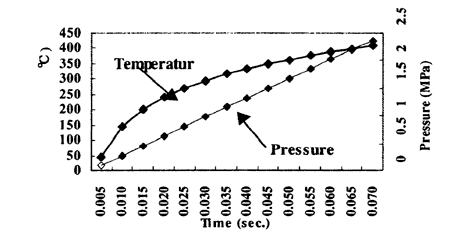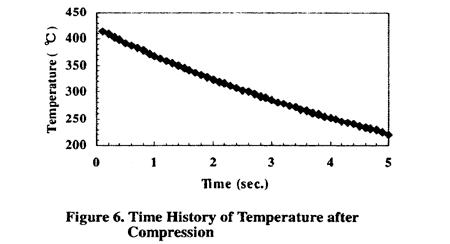
D: diameter of air manifold = 0.151 (m)
L: length of air manifold = 11.49 (m)
V: volume of air manifold = 0.21 (m3)
p0: initial pressure of air at manifold = 0.1 (MPa)
pu: pressure of air upstream of valve = 2.5 (MPa)
topen: Valve opening time = 0.1 (sec)
Av: maximum valve area = 0.0144 (m2)
Tu: temperature of air upstream of valve = 318 (K)
The results are
tcr was obtained from equation (9) as 0.07 (s). Because tcr is less than topen, maximum pressure rise rate was calculated from equation (11) as 35 (MPa/s). And maximum final temperature was calculated from equation (12) about 420 (℃). The calculated time history of temperature and pressure at the end of manifold over charging process are shown in Figure 5.

Figure 5. Calculated Temperature
Once the maximum is reached, the temperature decreases gradually. It can be simulated by calculating the heat loss term in equation (12). However at this circumstance, heat transfer coefficient will be much smaller than that during charging because there is no longer convection. We take it as 70 (J/m2sK) by keeping the temperature decreasing rate almost in agreement with that in reference [7]. The result is shown in Figure 6.

Figure 6. Time History of Temperature after Compression
As shown in Figure 6, the temperature will remain over 350℃ for more than one second. In this temperature condition, the possibility of potential auto-ignition of combustibles is discussed.
Many literatures have shown AIT for lubricating oil is about 240℃ to 280℃ at pressure of 2.0 MPa [8]. Unfortunately there was little date about ID for lubricating oil available. Experiments explained in reference [9] has shown a wick soaked with lubricating oil ignited at the final pressure and pressure rise rate equal to that of the sample. So, even there was only lubricating oil in air manifold, the possibility of ignition does exist.
As for fuel, Kazuo Hatori [10] has shown the ID for fuel oil C in a real engine.
BACK CONTENTS NEXT